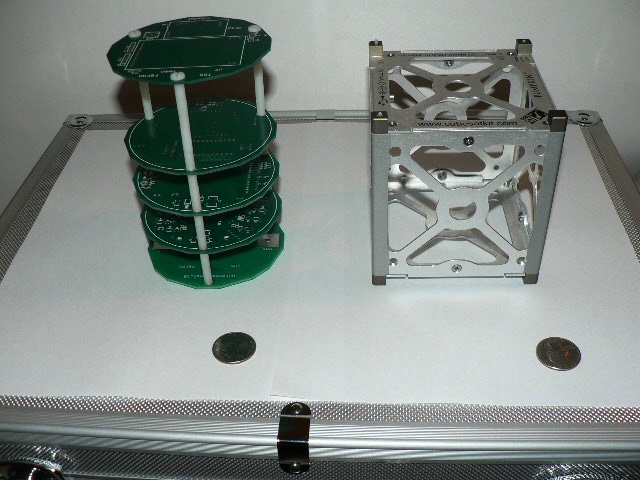All I ask is a successful launch, a clean radio signal, and a life just long enough to achieve that goal.
So you’re debating launching your own picosatellite? If high-altitude balloons just aren’t high altitude enough, if you feel frustrated by the pace of space development, or if you just really, really like rockets and hardware, I think launching your own satellite is an excellent decision. This book will help you turn that decision into a plan, and turn that plan into finished hardware. But first, what do you want your satellite to do?
Picosatellites, by definition, are extremely small, lightweight satellites. The progenitor of the pico class is the CubeSat, an open source architecture that lets you pack anything you want into the 10cm × 10cm × 10cm cube.
The CubeSat is a satellite as cute as a pumpkin. Forbes reported on one vendor, Pumpkin Inc., that supplies premade CubeSats. CubeSat itself is a specification, not a piece of off-the-shelf hardware, so Pumpkin decided to prebuild kits and sell them. If you have your own rocket to launch your CubeSat on, for $7,500 they’ll sell you a CubeSat kit.
This neatly parallels InterOrbital Systems’ TubeSat. InterOrbital Systems (IOS) has the edge in price/performance, as they throw the launch in for the same cost. But it looks like neither IOS nor Pumpkin provide premades, just kits. So there’s still hobbyist work involved, but kits remove the need for engineering and just leave the fun part of assembly and integration.
TubeSats and CubeSats are slightly different, of course, and I am insanely pleased that both are advancing the idea of platform kits. This is a great step in the commodification of space research. Even if the mini CubeSat looks eerily similar to a Hellraiser Lemarchand box. (See Figure 1-1.)
If you build a CubeSat, securing a rocket to launch it on is not difficult, merely expensive. A typical CubeSat launch cost is estimated at $40,000. There are several commercial providers promising future CubeSat rockets, assuming they complete development. Various NASA and International Space Station projects accept some proposals using the CubeSat architecture. There are more companies entering the private launch business each year, so prospects for getting a launch are becoming more robust.
The TubeSat architecture from InterOrbital Systems is an alternative schema. Currently only supported by InterOrbital, it is very cost-effective. You get the schematics, main hardware components, and a launch on their still-in-development rocket for the single price of $8,000. A TubeSat uses a slightly longer hexagonal architecture, 12cm in length and 4cm in diameter.
You can also work with a custom architecture if you have access to a rocket launch (through a college or university, perhaps), but currently the primary two players are the open CubeSat spec and the private TubeSat alternative. For purposes of this book, we’ll reference both the TubeSat kit and the Pumpkin CubeSat frame.
Any picosatellite will tend to have these core components:
- An antenna
- A radio transmitter for uplinking commands or downloading your data
- A computer-on-a-chip such as an Arduino or a Basic-X24
- A power system, most often solar cells plus a battery plus a power bus
- Sensors
Get DIY Satellite Platforms now with the O’Reilly learning platform.
O’Reilly members experience books, live events, courses curated by job role, and more from O’Reilly and nearly 200 top publishers.


